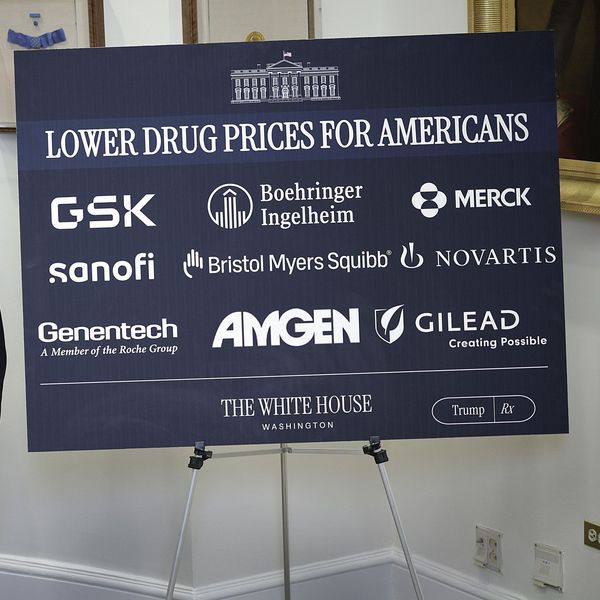
A demonstrator hold a sign demanding lower drug prices during a protest in Manhattan, New York, on August 16, 2023.
The Biden Administration Is Pulling Drug Prices Down Out of the Stratosphere
The president’s Inflation Reduction Act contained several provisions affecting drug prices, including three that began to take effect in 2023.
Prices for prescription drugs in America average almost three times as much as in other major nations around the world. Even more, the companies that set those prices are doing everything they can to make sure they stay in the stratosphere: They’ve filed suit to overturn an upcoming reform, having Medicare negotiate the prices of some of the costliest and most commonly used drugs.
The makers don’t think they need to explain themselves, either. If they hadn’t been threatened with subpoenas, their CEOs would never have showed up to waffle their way through a Senate hearing on drug pricing earlier this year.
Lastly, the companies argue that critics of high prices should instead be praising the industry for all the research it carries out to make the drugs available in the first place—failing to mention, of course, the critical role that government funding regularly plays in the development of new drugs.
If you wonder how patients could be harmed by lower drug prices, feel free to ask the Pharmaceutical Research and Manufacturers of America.
A big contributor to insane drug prices is the billions spent on those incessant drug commercials. Hour after hour, eyes glazing over, TV watchers are bombarded with happy-time ads for Rinvoq, Skyrizi, Dupixent, Sanofi, Jardiance, on and on and then some.
Thank heaven for mute buttons; more to the point, thank heaven that the Biden administration is leading the way to somewhat less insanity.
The president’s Inflation Reduction Act contained several provisions affecting drug prices, including three that began to take effect in 2023. The bill capped the price of insulin at $35 a month, made some vaccines free, and required drug companies that raised prices faster than the rate of inflation to pay rebates to Medicare.
Here’s President Joe Biden taking a victory lap during his State of the Union address: “That’s not just saving seniors money, it’s saving taxpayers money. We cut the federal deficit by $160 billion because Medicare will no longer have to pay those exorbitant prices…”
Other cost-saving provisions are coming as well. Starting in 2025, out-of-pocket prescription drug costs for retirees covered under Medicare Part D will be capped at $2,000. Annual limits after 2025 will be adjusted based on inflation rates.
Medicare-negotiated drug prices, mentioned earlier, have an effective date of 2026 (unless, of course, they get derailed by Big Pharma). Negotiations between Medicare and the makers are already underway for the first 10 covered drugs; all by themselves, those 10 accounted for over $3.4 billion in out-of-pocket costs in 2022.
Drug prices could fall even more sharply under the terms of the proposed 2025 budget for the Department of Health and Human Services. Instead of Medicare-negotiated prices for 10 drugs, the number would rise to 50 per year.
Presidents also have the power to make things happen without congressional legislation, and a Biden executive order could result in allowing states to import lower-cost drugs in bulk from Canada. The Food and Drug Administration approved Florida’s request early this year, and other states are hoping to follow. (Full disclosure: Florida’s Republican Gov. Ron DeSantis and former President Donald Trump also pushed for FDA’s approval.)
Drug companies reflexively oppose lower drug prices, so of course they reflexively oppose imports from Canada. A statement from their trade association said they were “considering all options for preventing this policy from harming patients.”
If you wonder how patients could be harmed by lower drug prices, feel free to ask the Pharmaceutical Research and Manufacturers of America. Another question too: Ask if they could please, please, please cut down on those commercials (or better yet, just end them).
An Urgent Message From Our Co-Founder
Dear Common Dreams reader, The U.S. is on a fast track to authoritarianism like nothing I've ever seen. Meanwhile, corporate news outlets are utterly capitulating to Trump, twisting their coverage to avoid drawing his ire while lining up to stuff cash in his pockets. That's why I believe that Common Dreams is doing the best and most consequential reporting that we've ever done. Our small but mighty team is a progressive reporting powerhouse, covering the news every day that the corporate media never will. Our mission has always been simple: To inform. To inspire. And to ignite change for the common good. Now here's the key piece that I want all our readers to understand: None of this would be possible without your financial support. That's not just some fundraising cliche. It's the absolute and literal truth. We don't accept corporate advertising and never will. We don't have a paywall because we don't think people should be blocked from critical news based on their ability to pay. Everything we do is funded by the donations of readers like you. Will you donate now to help power the nonprofit, independent reporting of Common Dreams? Thank you for being a vital member of our community. Together, we can keep independent journalism alive when it’s needed most. - Craig Brown, Co-founder |
Prices for prescription drugs in America average almost three times as much as in other major nations around the world. Even more, the companies that set those prices are doing everything they can to make sure they stay in the stratosphere: They’ve filed suit to overturn an upcoming reform, having Medicare negotiate the prices of some of the costliest and most commonly used drugs.
The makers don’t think they need to explain themselves, either. If they hadn’t been threatened with subpoenas, their CEOs would never have showed up to waffle their way through a Senate hearing on drug pricing earlier this year.
Lastly, the companies argue that critics of high prices should instead be praising the industry for all the research it carries out to make the drugs available in the first place—failing to mention, of course, the critical role that government funding regularly plays in the development of new drugs.
If you wonder how patients could be harmed by lower drug prices, feel free to ask the Pharmaceutical Research and Manufacturers of America.
A big contributor to insane drug prices is the billions spent on those incessant drug commercials. Hour after hour, eyes glazing over, TV watchers are bombarded with happy-time ads for Rinvoq, Skyrizi, Dupixent, Sanofi, Jardiance, on and on and then some.
Thank heaven for mute buttons; more to the point, thank heaven that the Biden administration is leading the way to somewhat less insanity.
The president’s Inflation Reduction Act contained several provisions affecting drug prices, including three that began to take effect in 2023. The bill capped the price of insulin at $35 a month, made some vaccines free, and required drug companies that raised prices faster than the rate of inflation to pay rebates to Medicare.
Here’s President Joe Biden taking a victory lap during his State of the Union address: “That’s not just saving seniors money, it’s saving taxpayers money. We cut the federal deficit by $160 billion because Medicare will no longer have to pay those exorbitant prices…”
Other cost-saving provisions are coming as well. Starting in 2025, out-of-pocket prescription drug costs for retirees covered under Medicare Part D will be capped at $2,000. Annual limits after 2025 will be adjusted based on inflation rates.
Medicare-negotiated drug prices, mentioned earlier, have an effective date of 2026 (unless, of course, they get derailed by Big Pharma). Negotiations between Medicare and the makers are already underway for the first 10 covered drugs; all by themselves, those 10 accounted for over $3.4 billion in out-of-pocket costs in 2022.
Drug prices could fall even more sharply under the terms of the proposed 2025 budget for the Department of Health and Human Services. Instead of Medicare-negotiated prices for 10 drugs, the number would rise to 50 per year.
Presidents also have the power to make things happen without congressional legislation, and a Biden executive order could result in allowing states to import lower-cost drugs in bulk from Canada. The Food and Drug Administration approved Florida’s request early this year, and other states are hoping to follow. (Full disclosure: Florida’s Republican Gov. Ron DeSantis and former President Donald Trump also pushed for FDA’s approval.)
Drug companies reflexively oppose lower drug prices, so of course they reflexively oppose imports from Canada. A statement from their trade association said they were “considering all options for preventing this policy from harming patients.”
If you wonder how patients could be harmed by lower drug prices, feel free to ask the Pharmaceutical Research and Manufacturers of America. Another question too: Ask if they could please, please, please cut down on those commercials (or better yet, just end them).
- 'Shameless Greed': Pharma Giant Merck Sues to Kill Medicare Drug Price Negotiations ›
- 'Appalling': Biden Administration Declines to Force Big Pharma to Cut Price of Prostate Cancer Drug ›
- Seniors Rejoice as President Biden Makes Lower Drug Prices for Older Americans the Law of the Land ›
- Critics Say Biden Plan to Cut Drug Costs Too Friendly to Big Pharma ›
- Federal Judge Tosses Big Pharma Lawsuit Against Medicare Drug Price Negotiations ›
- 'Stakes Are Huge': Medicare Makes Opening Bids in Price Negotiations With Big Pharma ›
- Harris' Cap on Drug Costs Would Save Americans Billions of Dollars | Common Dreams ›
Prices for prescription drugs in America average almost three times as much as in other major nations around the world. Even more, the companies that set those prices are doing everything they can to make sure they stay in the stratosphere: They’ve filed suit to overturn an upcoming reform, having Medicare negotiate the prices of some of the costliest and most commonly used drugs.
The makers don’t think they need to explain themselves, either. If they hadn’t been threatened with subpoenas, their CEOs would never have showed up to waffle their way through a Senate hearing on drug pricing earlier this year.
Lastly, the companies argue that critics of high prices should instead be praising the industry for all the research it carries out to make the drugs available in the first place—failing to mention, of course, the critical role that government funding regularly plays in the development of new drugs.
If you wonder how patients could be harmed by lower drug prices, feel free to ask the Pharmaceutical Research and Manufacturers of America.
A big contributor to insane drug prices is the billions spent on those incessant drug commercials. Hour after hour, eyes glazing over, TV watchers are bombarded with happy-time ads for Rinvoq, Skyrizi, Dupixent, Sanofi, Jardiance, on and on and then some.
Thank heaven for mute buttons; more to the point, thank heaven that the Biden administration is leading the way to somewhat less insanity.
The president’s Inflation Reduction Act contained several provisions affecting drug prices, including three that began to take effect in 2023. The bill capped the price of insulin at $35 a month, made some vaccines free, and required drug companies that raised prices faster than the rate of inflation to pay rebates to Medicare.
Here’s President Joe Biden taking a victory lap during his State of the Union address: “That’s not just saving seniors money, it’s saving taxpayers money. We cut the federal deficit by $160 billion because Medicare will no longer have to pay those exorbitant prices…”
Other cost-saving provisions are coming as well. Starting in 2025, out-of-pocket prescription drug costs for retirees covered under Medicare Part D will be capped at $2,000. Annual limits after 2025 will be adjusted based on inflation rates.
Medicare-negotiated drug prices, mentioned earlier, have an effective date of 2026 (unless, of course, they get derailed by Big Pharma). Negotiations between Medicare and the makers are already underway for the first 10 covered drugs; all by themselves, those 10 accounted for over $3.4 billion in out-of-pocket costs in 2022.
Drug prices could fall even more sharply under the terms of the proposed 2025 budget for the Department of Health and Human Services. Instead of Medicare-negotiated prices for 10 drugs, the number would rise to 50 per year.
Presidents also have the power to make things happen without congressional legislation, and a Biden executive order could result in allowing states to import lower-cost drugs in bulk from Canada. The Food and Drug Administration approved Florida’s request early this year, and other states are hoping to follow. (Full disclosure: Florida’s Republican Gov. Ron DeSantis and former President Donald Trump also pushed for FDA’s approval.)
Drug companies reflexively oppose lower drug prices, so of course they reflexively oppose imports from Canada. A statement from their trade association said they were “considering all options for preventing this policy from harming patients.”
If you wonder how patients could be harmed by lower drug prices, feel free to ask the Pharmaceutical Research and Manufacturers of America. Another question too: Ask if they could please, please, please cut down on those commercials (or better yet, just end them).
- 'Shameless Greed': Pharma Giant Merck Sues to Kill Medicare Drug Price Negotiations ›
- 'Appalling': Biden Administration Declines to Force Big Pharma to Cut Price of Prostate Cancer Drug ›
- Seniors Rejoice as President Biden Makes Lower Drug Prices for Older Americans the Law of the Land ›
- Critics Say Biden Plan to Cut Drug Costs Too Friendly to Big Pharma ›
- Federal Judge Tosses Big Pharma Lawsuit Against Medicare Drug Price Negotiations ›
- 'Stakes Are Huge': Medicare Makes Opening Bids in Price Negotiations With Big Pharma ›
- Harris' Cap on Drug Costs Would Save Americans Billions of Dollars | Common Dreams ›

